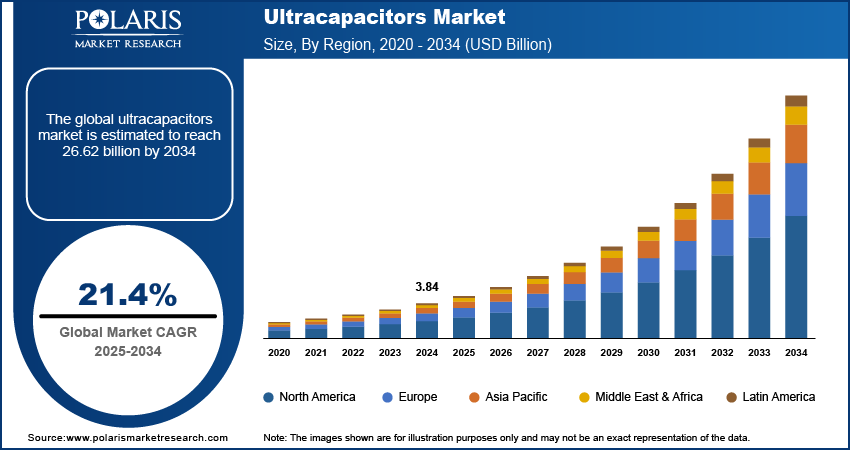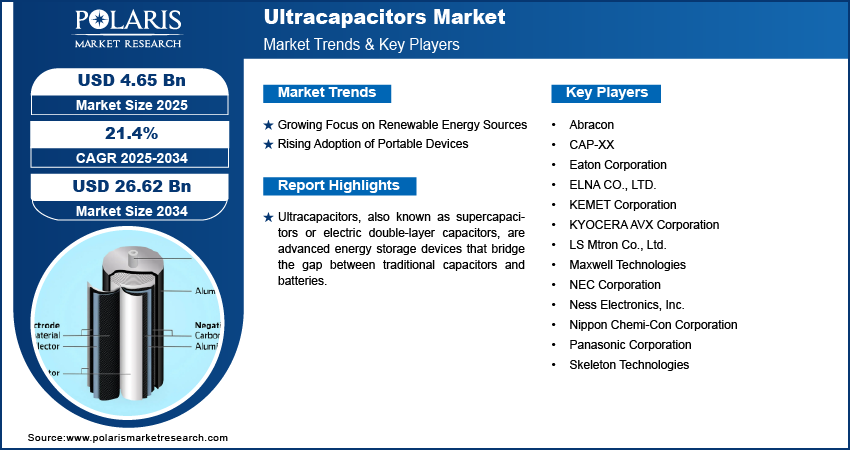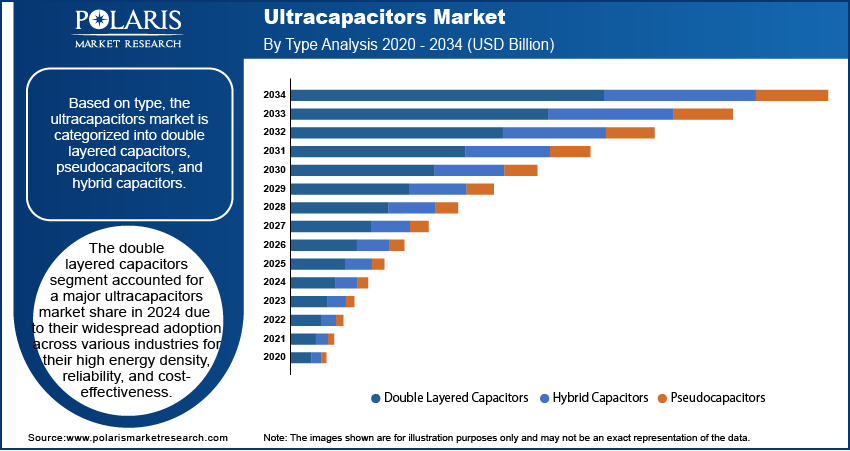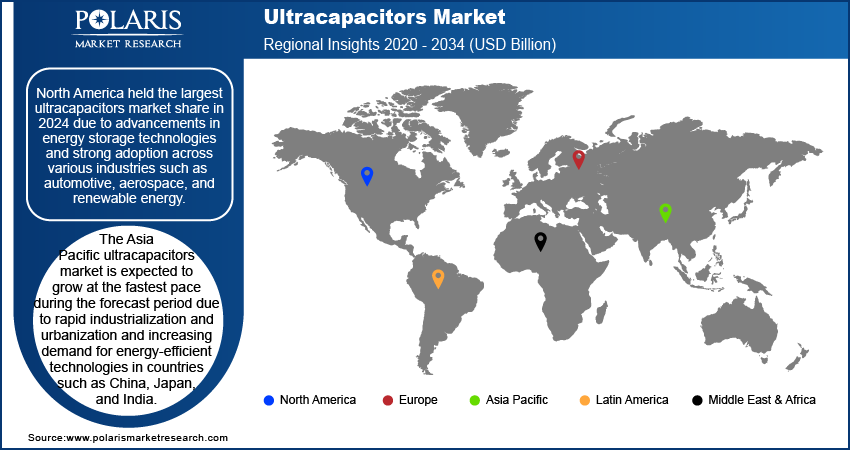
Ultracapacitors Market Size, Share, Trends, Industry Analysis Report: By Type (Double Layered Capacitors, Pseudocapacitors, and Hybrid Capacitors), Power, Application, and Region (North America, Europe, Asia Pacific, Latin America, and Middle East & Africa) – Market Forecast, 2025–2034
- Published Date:Feb-2025
- Pages: 129
- Format: PDF
- Report ID: PM1381
- Base Year: 2024
- Historical Data: 2020-2023
Ultracapacitors Market Overview
The global ultracapacitors market size was valued at USD 3.84 billion in 2024. The market is projected to grow from USD 4.65 billion in 2025 to USD 26.62 billion by 2034, exhibiting a CAGR of 21.4% during 2025–2034.
Ultracapacitors, also known as supercapacitors or electric double-layer capacitors, are advanced energy storage devices that bridge the gap between traditional capacitors and batteries. Ultracapacitors utilize electrostatic principles to store energy, allowing for much faster charge and discharge cycles. This unique mechanism involves storing energy in the form of ions within an electrolyte solution, leading to rapid energy release without the delays associated with chemical processes.

To Understand More About this Research: Request a Free Sample Report
The increasing shift toward electric vehicles is driving the global ultracapacitors market growth. According to data published by the International Energy Agency, almost 14 million new electric cars were registered globally in 2023, bringing their total number on the roads to 40 million. Ultracapacitors provide rapid charge and discharge capabilities, making them ideal for EV applications such as regenerative braking and providing bursts of power during acceleration. Furthermore, ultracapacitors have a longer lifespan, better temperature tolerance, and higher power density, which enhances the efficiency and reliability of EV systems, thereby increasing their adoption in electric vehicles.
Growing industrialization across the world propels the ultracapacitors market demand. There is an increased reliance on advanced machinery, automation, and equipment that require consistent and high-power energy delivery as industries expand. Ultracapacitors are highly efficient in providing rapid energy discharge, high power density, and durability, making them ideal for industrial applications such as power backup systems, grid stabilization, and energy recovery in heavy machinery. Additionally, their ability to operate in extreme temperatures and endure frequent charge-discharge cycles without significant degradation aligns with the demands of industrial environments. Hence, the demand for ultracapacitors increases with the rising industrialization globally.
Ultracapacitors Market Dynamics
Growing Focus on Renewable Energy Sources
The growing focus on renewable energy sources is projected to propel the global ultracapacitors market expansion. According to data published by the International Energy Agency, renewable energy sources are estimated to account for over 42% of global electricity generation by 2028. Ultracapacitors are increasingly utilized in renewable energy sources such as solar energy and wind energy due to their ability to store excess energy produced during peak generation times and discharge it during low production periods, effectively smoothing out energy variations and providing a stable energy supply to the power grid.
Rising Adoption of Portable Devices
The rising adoption of portable devices such as cameras, smartphones, laptops, and others is estimated to fuel the global ultracapacitors market growth. According to the State of Mobile Internet Connectivity Report 2023, over half (54%) of the global population owns a smartphone. Portable devices require fast, reliable, and sustainable power sources to support high-performance features such as rapid charging, extended battery life, and energy-demanding applications, including video games. Ultracapacitors, with their capability for quick charge-discharge cycles, durability, and lightweight design, provide an ideal solution for powering these portable devices. Therefore, the increasing adoption of these portable devices boosts the demand for ultracapacitors.

Ultracapacitors Market Segment Analysis
Ultracapacitors Market Assessment by Type
Based on type, the ultracapacitors market is categorized into double layered capacitors, pseudocapacitors, and hybrid capacitors. The double layered capacitors segment accounted for a major ultracapacitors market share in 2024 due to their widespread adoption across various industries for their high energy density, reliability, and cost-effectiveness. These capacitors are highly efficient in applications requiring frequent charge-discharge cycles, such as automotive systems, industrial machinery, and renewable energy storage. The robust design and ability of double layered capacitors to provide stable performance over extended lifespans make them a preferred choice for energy backup and regenerative braking systems. Moreover, advancements in manufacturing technologies have reduced production costs, further strengthening their market position. The increasing demand for efficient energy storage solutions in transportation and power grids has also contributed to their dominance in the market.
The hybrid capacitors segment is projected to grow at a rapid pace during the forecast period owing to their unique combination of high energy density and power performance. These capacitors integrate the advantages of double-layered and pseudocapacitors, making them suitable for next-generation applications. The growing focus on electrification in the automotive industry, including electric vehicles and plug-in hybrids, drives demand for hybrid capacitors as they address the limitations of traditional batteries. Additionally, their compact size and ability to operate efficiently under extreme conditions make them an attractive option for consumer electronics and military applications.
Ultracapacitors Market Evaluation by Application
In terms of application, the ultracapacitors market is divided into automotive, consumer electronics, energy, industrial, and others. The automotive segment dominated the market share in 2024 due to the increasing adoption of energy-efficient technologies in vehicles and the shift toward electrification in the transportation industry. Electric and hybrid vehicles rely heavily on advanced energy storage solutions, including ultracapacitors, to support regenerative braking systems, quick energy delivery, and enhanced fuel efficiency. The growing popularity of public transportation systems, such as electric buses, further contributed to the dominance of the automotive segment.

Ultracapacitors Market Regional Analysis
By region, the study provides the ultracapacitors market insights into North America, Europe, Asia Pacific, Latin America, and the Middle East & Africa. North America held the largest ultracapacitors market share in 2024 due to advancements in energy storage technologies and strong adoption across various industries such as automotive, aerospace, and renewable energy. The region's robust investments in research and development, coupled with government initiatives to promote clean energy and energy efficiency, have fueled market growth. The US, as the leading country in North America, contributed the most to this dominance due to its well-established infrastructure, high consumer demand for electric and hybrid vehicles, and widespread deployment of renewable energy projects. Additionally, the presence of key industry players and a strong focus on modernizing the electrical grid have further contributed to North America's dominance.
The Asia Pacific ultracapacitors market is expected to grow at the fastest pace during the forecast period due to rapid industrialization, urbanization, and increasing demand for energy-efficient technologies in countries such as China, Japan, and India. The region has emerged as a global manufacturing hub for the automotive and consumer electronics industries, both of which rely heavily on ultracapacitors. China's significant investments in renewable energy infrastructure and electric vehicle production have driven the ultracapacitors market expansion in the country. Similarly, Japan's leadership in technological innovation and India's expanding renewable energy projects and smart city initiatives are propelling market demand. According to the Central Electricity Authority, India’s renewable energy capacity crossed the 200 GW (gigawatt) mark as of October 10, 2024, constituting 46.3% of total capacity.

Ultracapacitors Market – Key Players and Competitive Analysis
Prominent market players are investing heavily in research and development to expand their offerings, which will boost the ultracapacitors market growth in the coming years. Market participants are also undertaking a variety of strategic activities to expand their global footprint, with important market developments such as innovative launches, international collaborations, higher investments, and mergers and acquisitions between organizations.
The ultracapacitors market is fragmented, with the presence of numerous global and regional market players. A few major players in the market are NEC Corporation; Abracon; Nippon Chemi-Con Corporation; Ness Electronics, Inc.; Panasonic Corporation; Skeleton Technologies; KYOCERA AVX Corporation; ELNA CO., LTD.; CAP-XX; Eaton Corporation; KEMET Corporation; LS Mtron Co., Ltd.; and Maxwell Technologies.
NEC Corporation established in 1899, is a prominent Japan-based multinational company headquartered in Tokyo, The company specializes in information technology and electronic solutions. NEC has evolved into a leader in the integration of IT and network technologies, providing a wide range of products and services that cater to various sectors, including telecommunications, healthcare, transportation, and public safety. In recent years, NEC has expanded its portfolio to include advanced energy storage solutions, particularly ultracapacitors.
Skeleton Technologies, founded in 2009, is a pioneering energy storage company that specializes in the development and manufacturing of ultracapacitors, particularly those enhanced with innovative materials such as curved graphene. Headquartered in Tallinn, Estonia, with significant operations in Germany, Skeleton has positioned itself as a leader in the ultracapacitor market by focusing on high-energy and power-density solutions. The company’s ultracapacitors are designed to meet the growing demand for efficient energy storage across various sectors, including automotive, transportation, industrial applications, and renewable energy systems. Skeleton's flagship product line, known as SkelCap, utilizes patented nanostructured carbon technology to achieve superior performance compared to conventional ultracapacitors. In July 2024, Skeleton Technologies launched its supercapacitors at the NTT IndyCar Series, a high-speed, open-wheel, single-seater formula racing series in North America.
List of Key Companies in Ultracapacitors Market
- Abracon
- CAP-XX
- Eaton Corporation
- ELNA CO., LTD.
- KEMET Corporation
- KYOCERA AVX Corporation
- LS Mtron Co., Ltd.
- Maxwell Technologies
- NEC Corporation
- Ness Electronics, Inc.
- Nippon Chemi-Con Corporation
- Panasonic Corporation
- Skeleton Technologies
Ultracapacitors Industry Developments
October 2023: KYOCERA AVX, a global manufacturer of advanced electronic components, expanded its PrizmaCap line of rugged, high-capacitance, and high-reliability supercapacitors with the release of a new Gen II series. The new Gen II PrizmaCap supercapacitors, also known as prismatic electrochemical double-layer capacitors (EDLCs), deliver higher capacitance, voltage, and energy density.
March 2023: Abracon, a major provider of frequency control, timing, power, magnetics, RF, and antenna solutions, announced the launch of an all-new line of 2.7V & 3.0V EDLC radial supercapacitors or ultracapacitors.
August 2021: KEMET, part of the YAGEO Group, announced the release of its new high-performance supercapacitors for automotive electronics, the FMD and FU0H series. These series deliver 1,000 hours at 85°C/85% RH-rated voltage and operational temperature ranging from –40°C to 85°C.
Ultracapacitors Market Segmentation
By Type Outlook (Revenue, USD Billion, 2020–2034)
- Double Layered Capacitors
- Pseudocapacitors
- Hybrid Capacitors
By Power Outlook (Revenue, USD Billion, 2020–2034)
- Less than 10 Volts
- 10 Volts to 25 Volts
- 25 Volts to 50 Volts
- 50 Volts to 100 Volts
- Above 100 Volts
By Application Outlook (Revenue, USD Billion, 2020–2034)
- Automotive
- Consumer Electronics
- Energy
- Industrial
- Others
By Regional Outlook (Revenue, USD Billion, 2020–2034)
- North America
- US
- Canada
- Europe
- Germany
- France
- UK
- Italy
- Spain
- Netherlands
- Russia
- Rest of Europe
- Asia Pacific
- China
- Japan
- India
- Malaysia
- South Korea
- Indonesia
- Australia
- Vietnam
- Rest of Asia Pacific
- Middle East & Africa
- Saudi Arabia
- UAE
- Israel
- South Africa
- Rest of Middle East & Africa
- Latin America
- Mexico
- Brazil
- Argentina
- Rest of Latin America
Ultracapacitors Market Report Scope:
|
Report Attributes |
Details |
|
Market Size Value in 2024 |
USD 3.84 billion |
|
Market Size Value in 2025 |
USD 4.65 billion |
|
Revenue Forecast by 2034 |
USD 26.62 billion |
|
CAGR |
21.4% from 2025 to 2034 |
|
Base Year |
2024 |
|
Historical Data |
2020–2023 |
|
Forecast Period |
2025–2034 |
|
Quantitative Units |
Revenue in USD Billion and CAGR from 2025 to 2034 |
|
Report Coverage |
Revenue Forecast, Market Competitive Landscape, Growth Factors, and Trends |
|
Segments Covered |
|
|
Regional Scope |
|
|
Competitive Landscape |
|
|
Report Format |
|
|
Customization |
Report customization as per your requirements with respect to countries, regions, and segmentation. |
FAQ's
• The global ultracapacitors market size was valued at USD 3.84 billion in 2024 and is projected to grow to USD 26.62 billion by 2034.
• The global market is projected to register a CAGR of 21.4% during the forecast period.
• North America held the largest share of the global market in 2024.
• A few of the key players in the market are NEC Corporation; Abracon; Nippon Chemi-Con Corporation; Ness Electronics, Inc.; Panasonic Corporation; Skeleton Technologies; KYOCERA AVX Corporation; ELNA CO., LTD.; CAP-XX; Eaton Corporation; KEMET Corporation; LS Mtron Co., Ltd.; and Maxwell Technologies.
• The hybrid capacitors segment is projected for a significant growth rate in the global market during 2025–2034.
• The automotive segment dominated the market in 2024.
